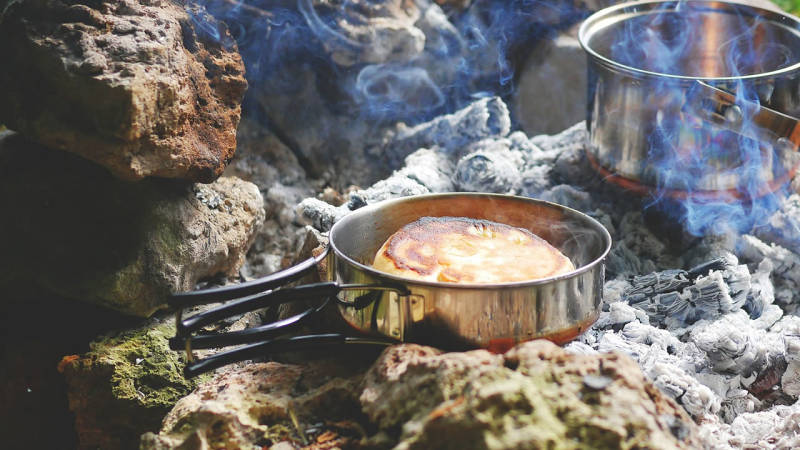
3 breads you bake without an oven in the wilderness
👉 The key facts from this guide
- The Bannock bread is a simple flatbread that is fried in a pan over the fire. It consists of flour, water, baking powder, salt, and fat or oil.
- Stock bread is a simple dough made of flour, sugar, water, and yeast, wrapped around a stick and baked over the fire.
- The "Hoe Cake" is a cornbread that was traditionally fried on the blade of a hoe. Today, it can also be fried in a pan or on an axe. It consists of flour, cornmeal, eggs, sugar, buttermilk, water, and vegetable oil or bacon.
To bake a bread, usually requires an oven.
But what do you do when you're in the wilderness and don't have an oven?
You are using a frying pan, turning the dough around a stick or using your axe as a frying pan.
Our ancestors did that too.
And today you will learn how to do it.
The basic recipe for bread - two ingredients
All breads have one thing in common: their dough is made of flour and water.
If you only have these two ingredients, you can always make bread from them. It doesn't taste like the one from the bakery next door, but that's not the point. You need food and flour gives you important carbohydrates.
I will now introduce you to three easy bread recipes for the wilderness.
![3 Brotrezepte für die Pfanne [für Survival und Bushcraft] Water and flour - the basic ingredients for almost all bread doughs](https://survival-kompass.de/img/artikel/wasser-und-mehl.jpg)
The Bannock Bread in the Frying Pan
The dough for it and the preparation is easy. You just have to make sure that the bread doesn't burn.
The Bannock bread is a flatbread that used to be baked in glowing ashes and then roasted again in a pan. However, we fry it directly in the pan.
![3 Brotrezepte für die Pfanne [für Survival und Bushcraft] The Bannock bread is very easy and quick to make](https://survival-kompass.de/img/artikel/bannock-brot-in-pfanne.jpg)
Ingredients for Bannock Bread
- 2 cups of flour
- 1 cup of water
- 2 teaspoons of baking powder
- ½ teaspoon of salt
- 2 tablespoons of fat or oil
Preparation
- Mix flour, baking powder, and salt
- Then add the water and knead everything together
- Let the dough rest for 5 to 10 minutes
Now add some oil to the cold pan and spread the dough in it. Spread it out so that it lies as flat as possible on the bottom of the pan. The flatter the dough in the pan, the faster it will be done. If you have to leave the dough in the pan for a long time, it will burn.
Then place the pan over the fire or on your Hobo stove. Turn the bread several times and add oil if necessary. The oil prevents your bread from burning on the bottom of the pan. After a few minutes (about 3 to 5), when the bread comes off the pan easily, your bannock bread is ready.
If it's about to burn, take it off the fire and let it cook a little longer.
Instead of using fat or oil, you can also use bacon or pork belly to grease the pan. The first Americans even used bear fat (read here for all the uses of fat).
Furthermore, the bread can be well refined with various ingredients:
- Bread spices
- Garlic, onions, or chili peppers
- Herbs (rosemary, wild garlic, dandelion)
- Chopped nuts (hazelnuts or walnuts)
- Sugar, for sweet bread
![3 Brotrezepte für die Pfanne [für Survival und Bushcraft] A Bannock with rosemary baked by me - looks delicious, doesn't it?](https://survival-kompass.de/img/artikel/bannock-brot-fertig.jpg)
The Stick Bread
Everyone has seen or made campfire bread before. As a child, it was always a must-have for me at the campfire.
The dough is also simple. Because the simpler, the better in the wilderness.
![3 Brotrezepte für die Pfanne [für Survival und Bushcraft] You only need a fire for stick bread - the dough is easy to make](https://survival-kompass.de/img/artikel/stockbrot.jpg)
Ingredients for Stockbrot
- 2 cups of flour
- 3 tablespoons of sugar
- 1 cup of water
- 1 teaspoon of yeast
- Extra flour for dusting and rolling
Furthermore, you still need a stick. It is best to take a moist and fresh stick.
The stick should be approximately two meters long, have a diameter of 1 cm, and be pointed at the back.
Preparation
- First, mix flour, sugar, and yeast
- Then gradually add the water
- Form a ball and then a dough strand
- Let the dough rest for about 10 minutes
Wrap the dough around the stick. Press it down a bit and hold your bread over the fire.
Your fire should not blaze too much. Hot coals are sufficient.
Occasionally turn your loaf so that it can bake evenly.
If you really want to go into detail and are looking for other alternatives to normal stick bread, read my detailed guide "Perfect stick bread recipe for campfires and grills: simple basic recipe, with and without yeast and without stick".
The "Hoe Cacke" - made on the hoe
This is an old recipe of the American settlers. They used to fry their bread on a hoe.
Since you probably don't have a hoe, you can use the blade of your axe (or a pan) instead. The bread resembles a cake, hence the name "Cake". However, it is a cornbread.
![3 Brotrezepte für die Pfanne [für Survival und Bushcraft] The “Hoe Cake” was traditionally fried on the metal of a hoe](https://survival-kompass.de/img/artikel/hacke.jpg)
The hoe was placed next to the fire and the hot iron baked one side of the cornbread, the heat of the fire simultaneously baking the other side.
Ingredients for "Hoe Cacke":
- 1 cup flour
- 1 cup cornmeal
- 2 eggs
- 1 tablespoon sugar
- ¾ cup buttermilk
- 1/3 cup plus 1 tablespoon water
- ¼ cup vegetable oil or bacon
- Oil for the pan or griddle
Mix everything together and fry your bread with some oil on the griddle, axe, or pan.
Turn the bread occasionally so it doesn't burn.
Recommendation for buying a pan
Maybe you don't have a pan yet, then I can recommend one to you.
When making a purchase, you should make sure that your pan is not too heavy. After all, you have to carry it.
For one person, I recommend the following pan:
0.8 liters fit in the pan and not only am I satisfied: the whole positive reviews speak for themselves.
Summary
These three recipes have been around for hundreds of years. They are simple and efficient.
You only need a few ingredients and can experiment a lot yourself.
Why not fry yourself bread at home in the pan? This way you can be sure that it will work even in the wilderness during Bushcrafting and survival training.
My recommendation: always take two cups of flour with you, you can find the water - then all you require is a fire to bake yourself bread in an emergency.
Pemmican goes well with the bread. In my guide about Pemmican I write extensively about this indigenous food.
Which recipe do you like the best?
Have you ever baked or roasted bread in the wilderness?
Share your thoughts with me in the comments below!


Author of the guide
Martin Gebhardt
Hey, I'm Martin. On my blog, you will learn the basics and numerous details about living in the wild. I think survival, bushcraft and the good life in nature are the keys to happiness. Find me here on Instagram or on YouTube. You can find more about my mission on the About Me page.
Was this guide helpful?
80 people found this guide helpful.
4.90 out of 5 points (82 Ratings)
Comments (0)
This post may contain affiliate links. So if you click on the links and make a purchase, I will receive a small commission at no additional cost to you. Click here, to learn more about it.



